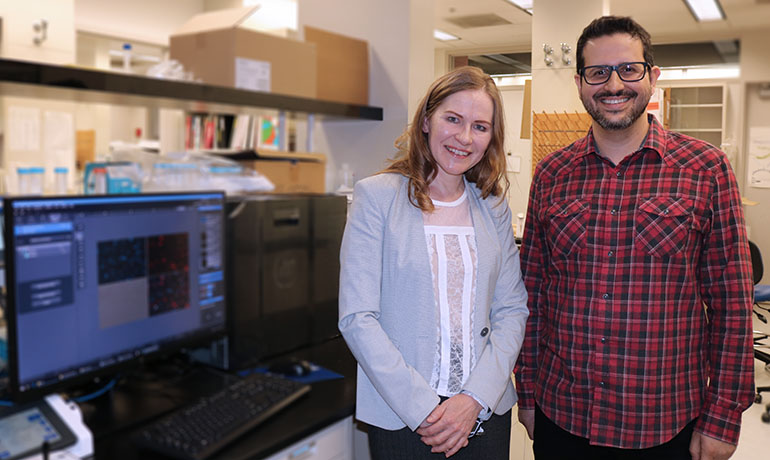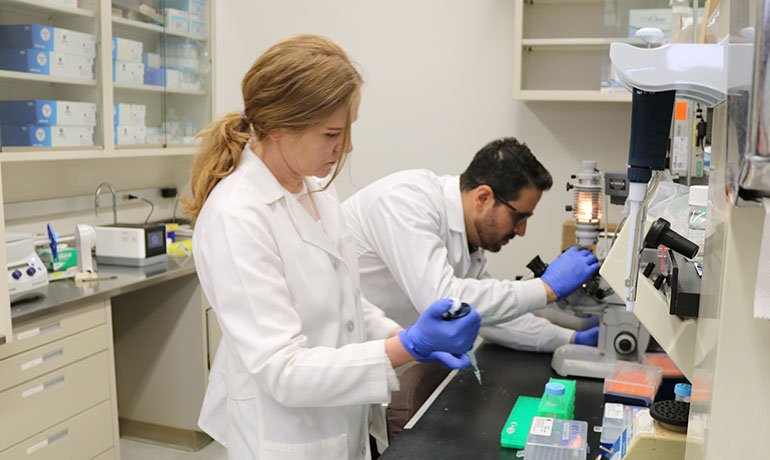
It’s in the mitochondria.
That’s where University of Illinois Cancer Center member Elizaveta Benevolenskaya believes the secret lies in how the retinoblastoma protein (pRB) stops cancer. Throughout her career, Benevolenskaya has been searching for a protein that explains the differentiation block seen in Rb-deficient cells.
“Restoration of normal pRB function is important to stopping cancer from growing,” said Benevolenskaya, associate professor of biochemistry and molecular genetics. “This explains why there is so much interest in this protein. Prior studies have shown that Rb-deficient cells were unable to properly grow, which mechanistically has been linked to the protein family E2F.

“Our lab has described a pRB function that is independent of pRB interaction with E2F, and links the RB pathway to mitochondrial metabolism and cell-type-specific transcription programs.”
Both of the RB functions are different from pRB regulation of the cell cycle and depend on the epigenetic factor KDM5A and on mitochondrial regulators, Benevolenskaya said. KDM5A formed complexes with pRB specifically in cells that were induced for differentiation, the process where cells change from one type to another. Further research found that KDM5A is a histone demethylase that binds at the start of transcriptionally active genes. KDM5A is an enzyme that can act as a repressor of transcription, she said.
“KDM5A removes methylation from a specific lysine residue in a histone protein – lysine 4 in histone H3 – which constitutes a core protein of the simplest structural unit of the chromosome,” Benevolenskaya said. “Once cells were induced for differentiation, pRB relocalized to the transcription start sites found by KDM5A and released them from KDM5A repression, increasing H3K4 methylation and expression level of corresponding genes.”
Further studies led Benevolenskaya to confirm that the removal of KDM5A is critical for cellular progression towards differentiation, as knocking out Kdm5a restores differentiation in Rb-deficient cells. Benevolenskaya ultimately discovered that pRb fastened on to an exclusive subset of Kdm5a targets, and the protein products of “all these genes had some function in the mitochondrion.
“When we saw that, we rushed to look at the mitochondria,” she said.
In her current research, which is funded by the National Cancer Institute (NCI), Benevolenskaya hypothesizes that pRb and Kdm5a binding to mitochondrial genes plays a regulatory role during differentiation.
“We tested an ambitious idea whether or not differentiation defects in Rb-negative cells can be ‘rescued’ through increased expression of a bona fide regulator of mitochondrial functions,” Benevolenskaya said. “Our studies so far suggest that KDM5A may represent an epigenetic regulator controlling the metabolic program that synchronizes energy homeostasis with a differentiation signal and thus could be therapeutically targeted separately.”
Drugs affecting metabolism or differentiation haven’t been broadly used yet to treat cancer. The use of drugs inducing differentiation was thought to be limited to particular tissue types, she said. However, pRB contains a number of essential functions, such as its interaction with KDM5A, that are shared by most tissues and potentially therapeutically targetable.
Current cancer therapy is aimed at eliminating rapidly dividing cells, rather than changing a tumorigenic cell phenotype and the transcription programs involved. Cytotoxic drugs used in chemotherapy were designed to arrest dividing cells by inducing DNA damage or targeting products of E2F-dependent genes. These therapeutic strategies, however, are generally toxic and many patients do not respond to the remedy. One example, Benevolenskaya said, is small cell lung cancer (SCLC), a highly aggressive cancer that accounts for 15 percent to 20 percent of all lung malignancies. Mutations in the RB gene occur in 95 percent of small cell lung cancer cases.
“We were able to show that KDM5A loss is highly efficient in the inhibition of formation of neuroendocrine tumors that are associated with the loss of Rb1 in mice and stops growth in human SCLC-derived cell lines,” she said. “We then began looking for therapeutic strategies not from a prospective of cell division, but specifying a cell fate or targeting metabolism of a cancer cell.”
Today, there are vastly improved approaches to study cell fate, including metabolomics studies and following the differentiation process by using live cell imaging; Benevolenskaya employs both. She is also collaborating with Nuria Lopez-Bigas, a renowned expert in functional analysis of genomics data at Institute for Research in Biomedicine in Barcelona, Spain. Because of Lopez-Bigas’ expertise, Benevolenskaya’s lab uses genome-wide approaches daily.
“Most recently, we became very excited about single cell RNA sequencing approaches that allows the determination of expression in thousands of genes in each cell,” she said. “I foresee that the single cell approaches will be highly effective in assessing Kdm5a inhibitors and other novel therapeutic approaches that can be used alongside existing cancer therapies.”
